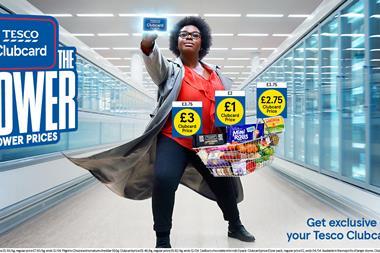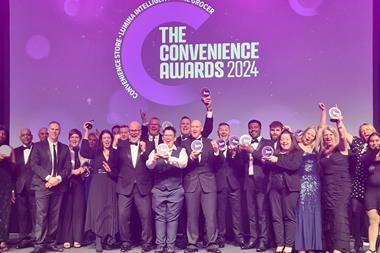The barcode’s successor is moving mainstream at a rapid pace
When Tesco announced a massive rollout of radio frequency ID tagging, it was a wake-up call to UK manufacturers and retailers. Suddenly it was less a matter of ‘if’ RFID would be rolled out and much more a question of when. But will 2004 be the year?
Promising to automate manual tasks, reduce errors and stockholding and dramatically improve traceability and availability, RFID is expected to generate millions of pounds in savings for both retailers and manufacturers.
Take Wal-Mart, seen as a key driver of adoption globally. Speaking at this week’s National Retail Federation Convention in New York, Wal-Mart’s president and CEO Lee Scott said: “We expect we will reduce mark downs, drive down inventory and improve stock turn as it helps to track product through the supply chain.”
Indeed, by improving supply chain traceability, it would “take $1bn out of [Wal-Mart’s] inventory”, he predicted.
The analysts go further, suggesting that RFID could slash 15% or $6.7bn from Wal-Mart’s labour costs because the need for employees to scan barcodes on pallets and cases in the supply chain would be eliminated.
Given the potential savings, it is no surprise that Tesco has followed the US lead. It expects to start tagging cases of selected products moving between its distribution centres and stores from April and to introduce its suppliers to the technology from September.
Anxious not to give the US giant any more of a head start, it was instrumental in Intel’s launch of a “European electronic product code user group,” which includes Metro, Carrefour, Procter & Gamble, Nestlé and Gillette among its members. Jon Stine, Intel’s global retail CPG manager, says. “Tesco knew we were already working with Metro and Carrefour on RFID-related initiatives and suggested we facilitate a user group to share experiences and ideas and ensure that European needs would be met.”
Meanwhile, Swiss co-op Migros plans to open the world’s first fully RFID item-level tagged shop in November (see box). And as part of its Future Store Initiative, Metro is set to become the first retailer to use RFID technology in the supply chain, from supplier through to stores. It plans to start discussions in May with 100 of its leading suppliers with a view to tagging all their pallets and transport crates for delivery to 10 of Metro’s central warehouses and 250 stores. Roll-out is due to begin in November. Chief information officer Zygmunt Mierdorf, says: “By January 1, 2006, we want to have more than 300 of our suppliers applying the tags and all business and distribution centres throughout Germany equipped to process the labels.”
A recent study by Accenture suggests RFID could increase retailers’ sales by 3% and manufacturers’ revenues by 1%. Some of the further benefits have already been shown by Marks and Spencer, which introduced RFID in August 2002. It tagged 2.5 million plastic crates used to ship fresh and chilled product and claims it is now
able to process orders faster and pack them later - allowing it to sell fresher food.
However, these are not the only incentives from RFID. Another is improved traceability in relation to food safety. Laurence Hutter, lead partner at Deloitte & Touche’s European consumer business division, says RFID technology provides a solution to assure safe supply from farm to fork. He believes it will play an important role in helping the grocery industry meet increased regulation, such as new European rules which come into effect on January 15, 2005. This sets out requirements on traceability for food and feed producers and requires information to be available to authorities on demand.
“RFID tags are robust and survive the life of the product,” he says. For example, at the farm they represent an increasingly viable and secure option to traditional ear tags, while at the processing plant they help to reduce cross-batch contamination.
With the momentum finally gathering behind RFID, the systems providers are busy fine-tuning the technology. Sun Microsystems is opening an RFID lab in Dallas, Texas, at the beginning of February and another facility in Linlithgow, Scotland later in the month to develop more standardised solutions, for instance.
Julie Sarbacker, director of Sun’s Auto ID business unit, says: “RFID projects tend to be 10% hardware/software investment and 90% support and services as the technology is immature. We want to move that to 30:70 quickly.”
Retailers are also getting ready. Carrefour is currently upgrading its systems to handle the huge volume of information generated by RFID tags “If you want to do RFID you have to do data synchronisation first,” explains Jeremy Hollows, director of B2B at Carrefour. And this month, Metro introduced a tag deactivator to its Rheinberg store allowing shoppers concerned about privacy rights to cancel any tag attached to merchandise they have bought.
Inevitably, the cost to suppliers remains an issue, although Scott says: “We have to be realistic. If any supplier can’t achieve compliance by our deadline, then we’ll back off, but everything we’ve heard from suppliers is positive.”
So will 2004 be the year for RFID? It should be, says Tony Hodgson, Deloitte supply chain partner: “The time is right: standards will soon be in place across Europe, the technology is proven in practice, and affordable. Early investment will give retailers a serious advantage over the competition next year. 2004 is the time to invest in RFID.”
When Tesco announced a massive rollout of radio frequency ID tagging, it was a wake-up call to UK manufacturers and retailers. Suddenly it was less a matter of ‘if’ RFID would be rolled out and much more a question of when. But will 2004 be the year?
Promising to automate manual tasks, reduce errors and stockholding and dramatically improve traceability and availability, RFID is expected to generate millions of pounds in savings for both retailers and manufacturers.
Take Wal-Mart, seen as a key driver of adoption globally. Speaking at this week’s National Retail Federation Convention in New York, Wal-Mart’s president and CEO Lee Scott said: “We expect we will reduce mark downs, drive down inventory and improve stock turn as it helps to track product through the supply chain.”
Indeed, by improving supply chain traceability, it would “take $1bn out of [Wal-Mart’s] inventory”, he predicted.
The analysts go further, suggesting that RFID could slash 15% or $6.7bn from Wal-Mart’s labour costs because the need for employees to scan barcodes on pallets and cases in the supply chain would be eliminated.
Given the potential savings, it is no surprise that Tesco has followed the US lead. It expects to start tagging cases of selected products moving between its distribution centres and stores from April and to introduce its suppliers to the technology from September.
Anxious not to give the US giant any more of a head start, it was instrumental in Intel’s launch of a “European electronic product code user group,” which includes Metro, Carrefour, Procter & Gamble, Nestlé and Gillette among its members. Jon Stine, Intel’s global retail CPG manager, says. “Tesco knew we were already working with Metro and Carrefour on RFID-related initiatives and suggested we facilitate a user group to share experiences and ideas and ensure that European needs would be met.”
Meanwhile, Swiss co-op Migros plans to open the world’s first fully RFID item-level tagged shop in November (see box). And as part of its Future Store Initiative, Metro is set to become the first retailer to use RFID technology in the supply chain, from supplier through to stores. It plans to start discussions in May with 100 of its leading suppliers with a view to tagging all their pallets and transport crates for delivery to 10 of Metro’s central warehouses and 250 stores. Roll-out is due to begin in November. Chief information officer Zygmunt Mierdorf, says: “By January 1, 2006, we want to have more than 300 of our suppliers applying the tags and all business and distribution centres throughout Germany equipped to process the labels.”
A recent study by Accenture suggests RFID could increase retailers’ sales by 3% and manufacturers’ revenues by 1%. Some of the further benefits have already been shown by Marks and Spencer, which introduced RFID in August 2002. It tagged 2.5 million plastic crates used to ship fresh and chilled product and claims it is now
able to process orders faster and pack them later - allowing it to sell fresher food.
However, these are not the only incentives from RFID. Another is improved traceability in relation to food safety. Laurence Hutter, lead partner at Deloitte & Touche’s European consumer business division, says RFID technology provides a solution to assure safe supply from farm to fork. He believes it will play an important role in helping the grocery industry meet increased regulation, such as new European rules which come into effect on January 15, 2005. This sets out requirements on traceability for food and feed producers and requires information to be available to authorities on demand.
“RFID tags are robust and survive the life of the product,” he says. For example, at the farm they represent an increasingly viable and secure option to traditional ear tags, while at the processing plant they help to reduce cross-batch contamination.
With the momentum finally gathering behind RFID, the systems providers are busy fine-tuning the technology. Sun Microsystems is opening an RFID lab in Dallas, Texas, at the beginning of February and another facility in Linlithgow, Scotland later in the month to develop more standardised solutions, for instance.
Julie Sarbacker, director of Sun’s Auto ID business unit, says: “RFID projects tend to be 10% hardware/software investment and 90% support and services as the technology is immature. We want to move that to 30:70 quickly.”
Retailers are also getting ready. Carrefour is currently upgrading its systems to handle the huge volume of information generated by RFID tags “If you want to do RFID you have to do data synchronisation first,” explains Jeremy Hollows, director of B2B at Carrefour. And this month, Metro introduced a tag deactivator to its Rheinberg store allowing shoppers concerned about privacy rights to cancel any tag attached to merchandise they have bought.
Inevitably, the cost to suppliers remains an issue, although Scott says: “We have to be realistic. If any supplier can’t achieve compliance by our deadline, then we’ll back off, but everything we’ve heard from suppliers is positive.”
So will 2004 be the year for RFID? It should be, says Tony Hodgson, Deloitte supply chain partner: “The time is right: standards will soon be in place across Europe, the technology is proven in practice, and affordable. Early investment will give retailers a serious advantage over the competition next year. 2004 is the time to invest in RFID.”



















No comments yet